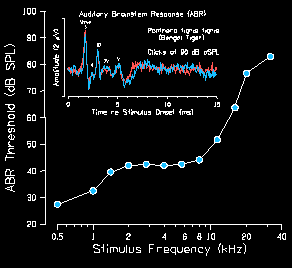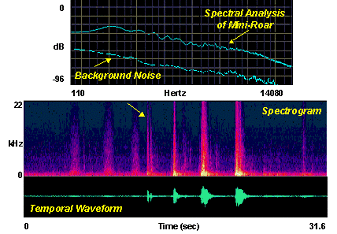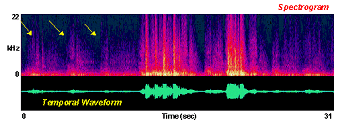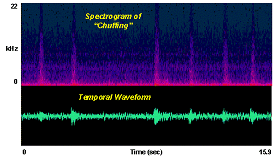Edward J. Walsh - walsh@boystown.org
Developmental Auditory Physiology Laboratory
Boys Town National Research Hospital
555 North 30th Street
Omaha, NE 68131
Lily M. Wang
University of Nebraska; College of Engineering and Technology
Douglas L. Armstrong, Thomas Curro, Lee G. Simmons
Henry Doorly Zoo
JoAnn McGee
Boys Town National Research Hospital
Popular version of paper 4aAB3
Presented Thursday morning, May 1, 2003
145th ASA Meeting, Nashville, TN
Introduction: To adults and children alike, tigers are one of the best-known members of the animal kingdom. It may be surprising, then, to learn that we have a lot to discover about their hearing and the acoustics of their vocalizations. To help fill in the gaps in our knowledge, we are in the midst of a study that is focused on the characterization of the vocal properties and hearing capabilities of a subset of surviving tiger subspecies, namely the Siberian, Bengal, Sumatran and the Indochinese tigers. We are hoping that our findings will not only add to a deeper understanding of these mysterious, solitary hunters, but will allow us to contribute to their preservation. However, this is not a small task given the seriousness of their endangerment.
Successfully communicating with prospective mates and competitors in the field poses a significant challenge to solitary hunters like free-ranging tigers whose hunting territories can be extensive - especially in the case of the Siberian subspecies whose members occupy the deciduous forests of eastern Russia. In that regard, the environmental transmission characteristics of low frequency and infrasonic acoustical signals (acoustic events that contain energy below the frequency range of human hearing) are ideally suited to support long distance communication among widely separated individuals, and tigers have long been recognized as a group that may have developed a vocal repertoire allowing them to establish and maintain hunting territories, identify and associate with mates, and provide females of the species with dependent cubs the opportunity to escape the infanticidal intentions of non-paternal males. Although the results of middle and inner ear studies suggest that low frequency acoustic energy is preferentially processed by the inner ears of tigers, the capacity of individuals to perceive low frequency and infrasonic acoustic events has not been determined and the overall frequency range over which tigers successfully navigate their acoustic landscape has been largely unknown until recently.
 a series of
precisely timed voltage peaks that represent the summed electrical activity
of excited neurons distributed along the auditory pathway from the VIIIth nerve
to the auditory cortex. An example of an ABR recorded from a Bengal tiger, along
with a Threshold vs. Frequency Curve, also known as an audiogram, is shown in
the figure to the left. Audiograms representing each of the tiger subspecies
studied were sufficiently similar to allow data to be pooled and the generation
of the "average tiger audiogram" shown here. As can be seen in the figure, tigers
are relatively insensitive to acoustic signals containing predominantly high
frequency energy (e.g., ~32 kiloHertz) and sensitivity gradually improves
as tone burst frequency is decreased with animals being most sensitive to the
lowest frequency studied thus far, 500 Hertz, clearly confirming that the most
sensitive portion of the tiger's "range of hearing" lies in the low frequency
portion of their audible spectrum. Furthermore, the shape of the average tiger
audiogram and the relative size of their inner ears (i.e., their cochleae)
suggests that individuals may - and probably do - hear acoustic events carried
by signals in the near infrasonic and the infrasonic range. An investigation
to assess low frequency auditory receptivity is the focus of ongoing research
intended to more completely determine the limits of auditory performance in
tigers.
a series of
precisely timed voltage peaks that represent the summed electrical activity
of excited neurons distributed along the auditory pathway from the VIIIth nerve
to the auditory cortex. An example of an ABR recorded from a Bengal tiger, along
with a Threshold vs. Frequency Curve, also known as an audiogram, is shown in
the figure to the left. Audiograms representing each of the tiger subspecies
studied were sufficiently similar to allow data to be pooled and the generation
of the "average tiger audiogram" shown here. As can be seen in the figure, tigers
are relatively insensitive to acoustic signals containing predominantly high
frequency energy (e.g., ~32 kiloHertz) and sensitivity gradually improves
as tone burst frequency is decreased with animals being most sensitive to the
lowest frequency studied thus far, 500 Hertz, clearly confirming that the most
sensitive portion of the tiger's "range of hearing" lies in the low frequency
portion of their audible spectrum. Furthermore, the shape of the average tiger
audiogram and the relative size of their inner ears (i.e., their cochleae)
suggests that individuals may - and probably do - hear acoustic events carried
by signals in the near infrasonic and the infrasonic range. An investigation
to assess low frequency auditory receptivity is the focus of ongoing research
intended to more completely determine the limits of auditory performance in
tigers. Although more work is required to completely map the low frequency boundary of tiger hearing, it is relatively clear that at least a subset of surviving tiger subspecies produce prodigious amounts of low frequency and infrasonic acoustic energy in their utterances, most notably in the form of roars. Although the vocal repertoire of the tiger is considerable, consisting largely of grunts and growls, roars and moans, snarls and chuffs, and hisses and gasps, the spectral diversity of utterances comprising these categories is limited. Unlike the spectrally complex vocalization patterns of many other animals, notably represented by birds and bats, tigers produce sounds that are spectrally "full," that is they contain energy in a continuous, broadband spectrum ranging from infrasonic to ultrasonic frequency bands. The acoustic energy contained in growls, roars and a friendly greeting known as chuffing, or prusten, produced by an adult male Siberian tiger are compared in a series of spectrograms (graphic displays illustrating how the distribution of acoustic energy at different frequencies changes over time) and associated spectral analyses of selected utterances in the following plots.
 In the plot
to the right, the spectral characteristic of a roar is depicted graphically.
Although the utterance contains a large amount of acoustic energy in the low
frequency band - the intense, "yellow hot" band at the lower boundary of the
spectrogram - it is notable that this communication signal contains significant
acoustic energy in higher frequency bands as well. Examination of the associated
spectrum of the roar relative to the background noise in the recording environment
(see "spectral analysis") shows that the peak acoustic power of that utterance
is contained in a band around 300 Hertz, similar to the frequency range that
tigers appear to be most sensitive to acoustic events. Click on the speaker
icon
In the plot
to the right, the spectral characteristic of a roar is depicted graphically.
Although the utterance contains a large amount of acoustic energy in the low
frequency band - the intense, "yellow hot" band at the lower boundary of the
spectrogram - it is notable that this communication signal contains significant
acoustic energy in higher frequency bands as well. Examination of the associated
spectrum of the roar relative to the background noise in the recording environment
(see "spectral analysis") shows that the peak acoustic power of that utterance
is contained in a band around 300 Hertz, similar to the frequency range that
tigers appear to be most sensitive to acoustic events. Click on the speaker
icon ![]() to hear a sample of the roar and note the low level growl (an utterance with
considerable energy in the very low frequency/infrasound range) that follows
the roar - this sequence is typical of a roaring tiger and most likely serves
to even further intimidate a rival.
to hear a sample of the roar and note the low level growl (an utterance with
considerable energy in the very low frequency/infrasound range) that follows
the roar - this sequence is typical of a roaring tiger and most likely serves
to even further intimidate a rival.
 In the figure
to the left, an interesting, continuously recorded series of vocal utterances
In the figure
to the left, an interesting, continuously recorded series of vocal utterances
![]() illustrate the diversity of the tiger's vocal repertoire. The segment begins
with three breathy utterances that are spectrally characterized by a nearly
flat band of low frequency energy extending out to roughly 800-900 Hertz. These
are followed by a sequence of four roars, each escalating in production intensity
in sequence. In the first "mini-roar" (see arrow), the cat produces two brief
syllables and a follow-up short, low-level growl that leads to a sequence of
three brief but very impressive roars. It is interesting that the spectral characteristics
of the "mini-roar" share features of the breathy utterance (i.e., relatively
flat spectrum out to about 700 Hertz) and the full bodied roar that produces
peak acoustic energy in a band around 300 Hertz, a frequency region that - again
- tends to match the most sensitive portion of the big cats' audiometric range
thus far studied. The prussing or chuffing sounds of a Siberian in a neighboring
cage can be heard on the trailing edge of the record.
illustrate the diversity of the tiger's vocal repertoire. The segment begins
with three breathy utterances that are spectrally characterized by a nearly
flat band of low frequency energy extending out to roughly 800-900 Hertz. These
are followed by a sequence of four roars, each escalating in production intensity
in sequence. In the first "mini-roar" (see arrow), the cat produces two brief
syllables and a follow-up short, low-level growl that leads to a sequence of
three brief but very impressive roars. It is interesting that the spectral characteristics
of the "mini-roar" share features of the breathy utterance (i.e., relatively
flat spectrum out to about 700 Hertz) and the full bodied roar that produces
peak acoustic energy in a band around 300 Hertz, a frequency region that - again
- tends to match the most sensitive portion of the big cats' audiometric range
thus far studied. The prussing or chuffing sounds of a Siberian in a neighboring
cage can be heard on the trailing edge of the record.
 Still another
typical vocal sequence produced by a Siberian tiger is illustrated in the figure
to the right. The record begins with three breathy growls (yellow arrows) that
are followed by four very brief, energetic roar bursts (and associated cage
rattling) showing the same power peak at ~300 Hertz as in other roar records.
The "growl" is distinctive relative to the "roar" in that growls are produced
at a lower level and do not show the 300 Hertz energy peak that is characteristic
of roars.
Still another
typical vocal sequence produced by a Siberian tiger is illustrated in the figure
to the right. The record begins with three breathy growls (yellow arrows) that
are followed by four very brief, energetic roar bursts (and associated cage
rattling) showing the same power peak at ~300 Hertz as in other roar records.
The "growl" is distinctive relative to the "roar" in that growls are produced
at a lower level and do not show the 300 Hertz energy peak that is characteristic
of roars. ![]()
 Last,
a spectrogram representing the friendly flutter of a "chuff" sequence, a very
low level greeting call made by passing expired air through both the nose and
lips, is shown on the left. A "chuff" sounds like the tiger's version of the
"raspberries"
Last,
a spectrogram representing the friendly flutter of a "chuff" sequence, a very
low level greeting call made by passing expired air through both the nose and
lips, is shown on the left. A "chuff" sounds like the tiger's version of the
"raspberries" ![]() .
The peak energy contained in the greeting lies in the low frequency band and
acoustic power drops gradually off as higher and higher frequency bands are
measured. Note that while each of the utterances considered here is distinctive,
all tend to contain acoustic energy in the low frequency bands, confirming,
as it were, the importance of this portion of the audible spectrum.
.
The peak energy contained in the greeting lies in the low frequency band and
acoustic power drops gradually off as higher and higher frequency bands are
measured. Note that while each of the utterances considered here is distinctive,
all tend to contain acoustic energy in the low frequency bands, confirming,
as it were, the importance of this portion of the audible spectrum.
One of the short-term goals of our research is to determine if the temporal and/or spectral pattern of utterances like those illustrated here contain an "acoustic fingerprint" that will allow the discrimination of individuals on the basis of their vocal characteristics. If such discrimination efforts prove to be successful and reliable, arrays of remote acoustic monitoring devices could be used as the centerpiece of a census-monitoring program in their natural habitat. However, before serious attention can be paid to the issue of acoustics as a conservation tool, it is important to characterize the auditory and vocal attributes of these magnificent animals generally.